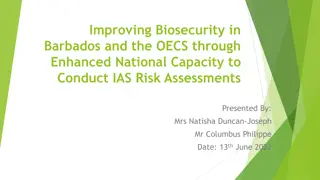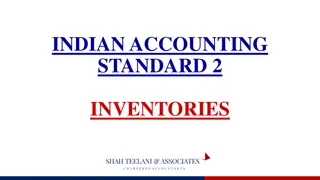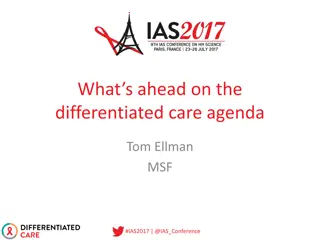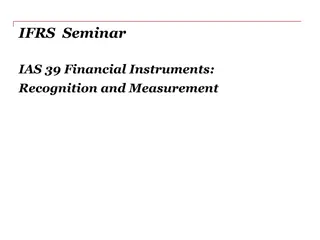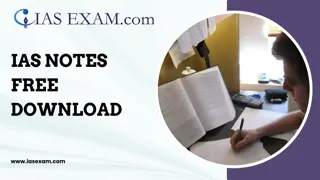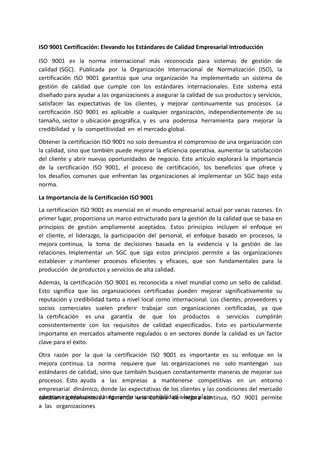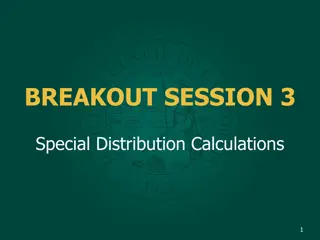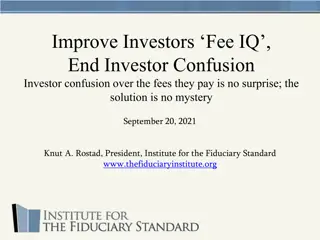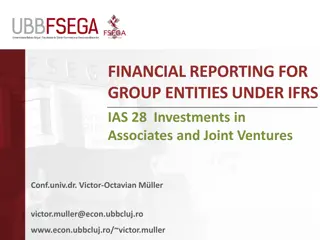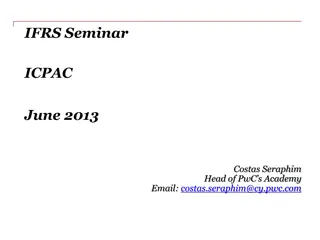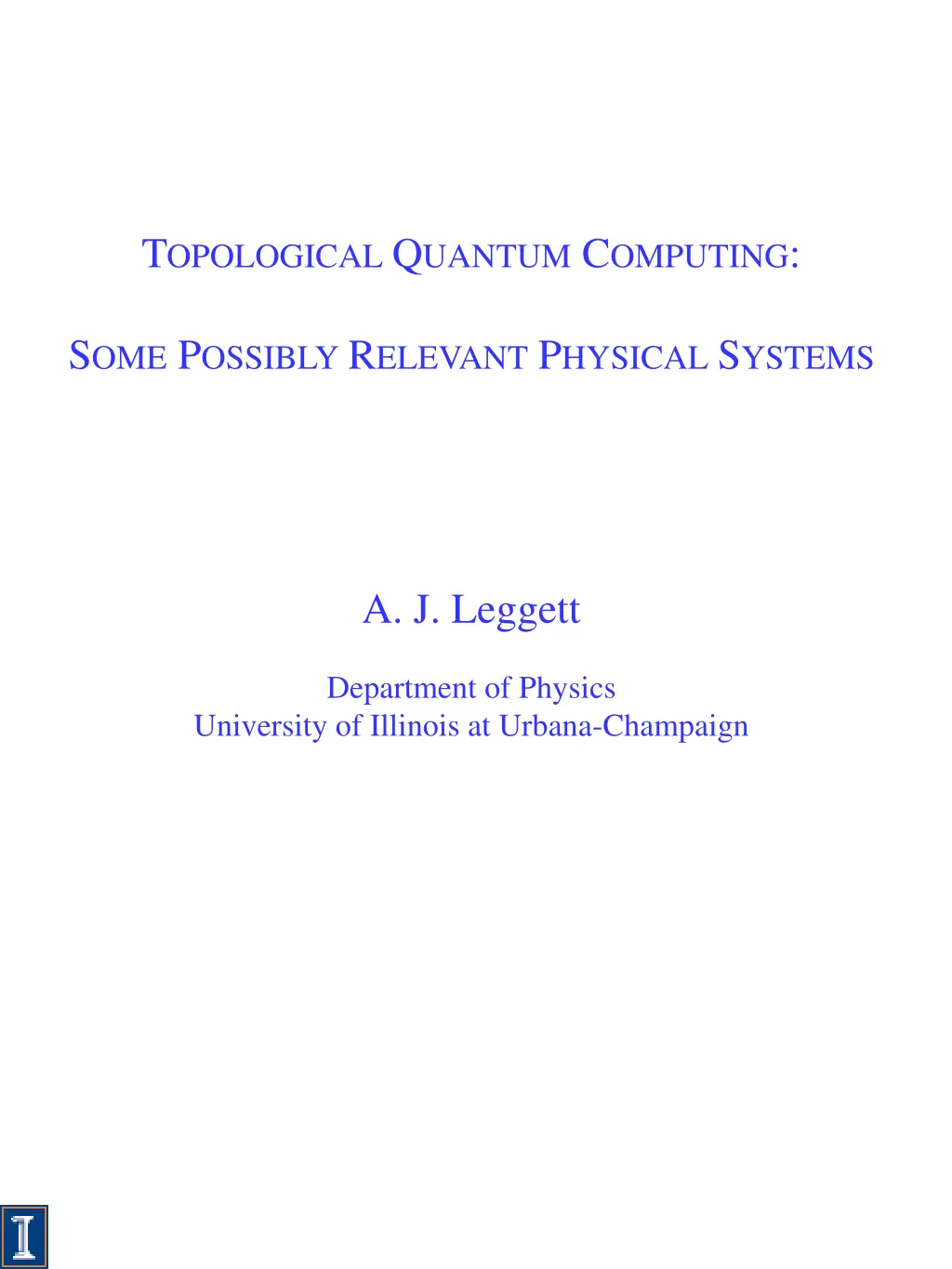
Quantum Computing with Topological Systems
Explore the potential of topological quantum computing using physically relevant systems, such as the Fractional Quantum Hall Effect on a torus. Understanding topological protection and anyons in 2D systems can pave the way for novel quantum computing approaches and enhanced computational capabilities.
Download Presentation

Please find below an Image/Link to download the presentation.
The content on the website is provided AS IS for your information and personal use only. It may not be sold, licensed, or shared on other websites without obtaining consent from the author. If you encounter any issues during the download, it is possible that the publisher has removed the file from their server.
You are allowed to download the files provided on this website for personal or commercial use, subject to the condition that they are used lawfully. All files are the property of their respective owners.
The content on the website is provided AS IS for your information and personal use only. It may not be sold, licensed, or shared on other websites without obtaining consent from the author.
E N D
Presentation Transcript
TOPOLOGICAL QUANTUM COMPUTING: SOME POSSIBLY RELEVANT PHYSICAL SYSTEMS A. J. Leggett Department of Physics University of Illinois at Urbana-Champaign
IAS-b-2 TOPOLOGICAL QUANTUM COMPUTING/MEMORY Qubit basis. | , | | = | + | To preserve, need (for resting qubit) H in | , | basis H H 1 = = ( 0 " ": const " ") H T T 12 on the other hand, to perform (single-qubit) operations, need to impose nontrivial . H 1 11 22 2 we must be able to do something Nature can t. (ex: trapped ions: we have laser, Nature doesn t!) Topological protection: would like to find d (>1) dimensional Hilbert space within which (in absence of intervention) ( .) const H = 1 / L + ( ) o e size of system microscopic length How to find degeneracy? , , s.t. Suppose two operators 1 2 , H , H = = [ ] [ but ] ] 0 (and com mute with b.c 's) 1 2 1 2 [ | > , 0 (and 0) 1 2 1 then Hilbert space at least 2-dimensional
IAS-b-3 EXAMPLE OF TOPOLOGICALLY PROTECTED STATE: FQH SYSTEM ON TORUS (Wen and Niu, PR B 41, 9377 (1990)) Reminders regarding QHE: 2D system of electrons, B plane Area per flux quantum = (h/eB) df. ( / M eB ( 100 for B = 10 T) M A 1/2 ) magnetic length Filling fraction no. of electrons/flux quantum FQH when = p/q incommensurate integers Argument for degeneracy: (does not need knowledge of w.f.) can define operators of magnetic translations ( ), a ( ) b T T ( translations of all electrons through a(b) appropriate phase factors). In general x y ( ), a ( )] b [ 0 T T x y
IAS-b-4 In particular, if we choose = 2 M ( / 2 L L ) no. of flux quanta 1 2 = = a L b L / , / N N s s 1 2 , T T then commute with b.c. s (?) and moreover 1 2 T T exp 2 T T = i 1 2 2 1 But the o. of m. of a and b is M ( M /L) osc M, and 0 for L . Hence to a very good approximation, [ , so since [ , T T ] [ , = = ] 0 0 (*) T H T H 1 2 ] 1 2 must more than 1 GS (actually q). Corrections to (*): suppose typical range of (e.g.) external potential V(r) is o, then since | > s oscillate on scale osc, | | ~ exp / ~ exp / H L o osc 2 1 ( const. 1) + 2/ M o
IAS-b-5 TOPOLOGICAL PROTECTION AND ANYONS Anyons (df): exist only in 2D = ) (2,1) (1,2) exp(2 (1,2) i T 12 (bosons: = 1, fermions: = ) = 12 23 T T 23 12 T T abelian if (ex: FQHE) nonabelian if , i.e. if 12 23 23 T T T T 12 1 2 1 2 3 1 2 ("braiding statistics")
IAS-b-6 Nonabelian statistics* is a sufficient condition for (partial) topological protection: [not necessary, cf. FQHE on torus] (a) state containing n anyons, n 3: ] [ = = [ , , ] 0 T H T H 12 T 23 [ , ] 0 T 12 23 space must be more than 1D. (b) groundstate: GS GS create anyons annihilate anyons annihilation process inverse of creation *plus gap for anyon creation GS also degenerate. Nonabelian statistics may (depending on type) be adequate for (partially or wholly) topologically protected quantum computation
IAS-b-7 SPECIFIC MODELS WITH TOPOLOGICAL PROTECTION 1. FQHE on torus Obvious problems: (a) QHE needs GaAs AlGaAs or Si MOSFET: how to bend into toroidal geometry? QHE observed in (planar) graphene (but not obviously fractional !): bend C nanotubes? (b) Magnetic field should everywhere have large compt to surface: but div B = 0 (Maxwell)! (c) anyway, anyons are Abelian, so permits only topological protection (not TP computation) 2. Spin Models (Kitaev et al.) (adv: exactly soluble) (a) Toric code model p Particles of spin on lattice s A = H B s p s p A x z , B s p j j j s j p ] A B (so [ , 0 in general) s p Problems: (a) in original formulation, toroidal geometry required (as in FQHE) (b) apparently v. difficult to generate Hamn physically however, developments of this idea surface codes using Josephson qubits
IAS-b-8 SPIN MODELS (cont.) subl. A subl. B (b) Kitaev honeycomb model Particles of spin on honeycomb lattice (2 inequivalent sublattices, A and B) y x z x z z k y k y = j j j x k H H J J J z x y x links nb: spin and space axes independent z links y links sites Strongly frustrated model, but exactly soluble.* Sustains nonabelian anyons with gap provided + | | + | | | J | | + |, | J | | |, J J J J J J x y z y z x | | H | | | | and 0 J z x y (in opposite case anyons are abelian + gapped) Advantages for implementation: (a) plane geometry (with boundaries) is OK H (b) bilinear in nearest-neighbor spins (c) permits partially protected quantum computation. * A. Yu Kitaev, Ann. Phys. 321, 2 (2006) H-D. Chen and Z. Nussinov, cond-mat/070363 (2007) (etc. )
IAS-b-9 Can we Implement Kitaev Honeycomb Model? One proposal (Duan et al., PRL 91, 090492 (2003)): use optical lattice to trap ultracold atoms V0 Optical lattice: potential, e.g. of form 3 counterpropagating pairs of laser beams create (2 / laser wavelength) 2 2 2 = + + ( ) r (cos cos cos ) V V kx ky kz o in 2D, 3 counterpropagating beams at 120 can create honeycomb lattice (suppress tunnelling along z by high barrier) For atoms of given species (e.g. 87Rb) in optical lattice 2 characteristic energies: e const. V (~ ) interwell tunnelling, t 0 intrawell atomic interaction (usu. repulsion) U For 1 atom per site on average: if t U, mobile ( superfluid ) phase if t U, Mott-insulator phase (1 atom localized on each site) tunnelling AF interaction H If 2 hyperfine species ( spin 1/2 particle), weak intersite 2 = = / J J t U i j AF nn (irrespective of lattice symmetry). So far, isotropic, so not Kitaev model. But
IAS-b-10 If tunnelling is different for and , then H berg Hamiltonian is anisotropic: for fermions, 2 2 2 nn U + t t t t y y j z i z j x x j = + i + i ( ) H AF U nn if t , get Ising-type intn H = i z z j const. AF nn We can control t and t with respect to an arbitrary z axis by appropriate polarization and tuning of (extra) laser pair. So, with 3 extra laser pairs polarized in mutually orthogonal directions (+ appropriately directed) can implement y bond x bond s y y j x x z z j = + i + i H J J J x y z i j z bon s d s Kitaev honeycomb model Some potential problems with optical-lattice implementation: (1) In real life, lattice sites are inequivalent because of background magnetic trap region of Mott insulator limited, surrounded by superfluid phase. 12 = 1pK. (10 K) T (2) to avoid thermal excitation, need (3) Even if T < 1pK, v. long spin relaxation times in ultracold atomic gases true groundstate possibly never reached. Other possible implementations: e.g. Josephson circuits (You et al., arXiv: 0809.0051)
IAS-b-11 QUANTUM HALL SYSTEMS Reminder re QHE: Occurs in (effectively) 2D electron system ( 2DES ) (e.g. inversion layer in GaAs GaAlAs heterostructure) in strong perpendicular magnetic field, under conditions of high purity and low ( 250 mK) temperature. If df. lm ( /eB)1/2( magnetic length ) then area per flux quantum h/e is , so no. of flux quanta (A area of sample). If total no. of electrons is Ne, define ( filling factor ) / e v N N QHE occurs at and around (a) integral values of (integral QHE) and (b) fractional values p/q with fairly small ( 13) values of q (fractional QHE). At th step, Hall conductance xyquantized to e2/ and longitudinal conductance xx0 2 m 2 = / 2 A l 2 m l Nb: (1) Fig. shows IQHE only 3 xy/(e2/h) 2 (2) expts usually plot 1 H vs R B 1 xy xx so general pattern is same but details different 1 2 3 nh/eB
IAS-b-12 = 5/2 STATE: THE PFAFFIAN ANSATZ Consider the Laughlin ansatz formally corresponding to = 1/2 (or = 5/2 with first 2 LC s inert): 2 ( ) exp i j i j N z z = L 2 2 m | | /4 z l (iz = electron coord.) i i This cannot be correct as it is symmetric under i j. So must multiply it by an antisymmetric function. On the other hand, do not want to spoil the exponent 2 in numerator, as this controls the relation between the LL states and the filling. Inspired guess (Moore & Read, Greiter et al.): (N = even) ( ) N N Pf f ij f f ( ) L 1 = P f z f z i j + ( Pfaffian) ( ( )) (12) (34)... (1 3) (24).... .... f antisymmetric und This state is the exact GS of a certain (not very realistic) 3- body Hamiltonian, and appears (from numerical work) to be not a bad approximation to the GS of some relatively realistic Hamiltonians. er ij created, just as in the Laughlin state, by the operation ( 1 ( i i qh z = It is routinely stated in the literature that the charge of a quasihole is e/4 , but this does not seem easy to demonstrate directly: the arguments are usually based on the BCS analogy (quasihold h/2e vortex, extra factor of 2 from usual Laughlin-like considerations) or from CFT. With this GS, a single quasihole is postulated to be ) N = ) N 0 conformal field theory These excitations are nonabelian ( Ising ) anyons. permit partially protected quantum computation.
IAS-b-13 p-WAVE FERMI SUPERFLUIDS (in 2D) Generically, particle-conserving wave function of a Fermi superfluid (Cooper-paired system) is of form = + + N /2 N ( ) | c a a vac N k k k , k e.g. in BCS superconductor = + + N /2 N ( ) | c a a vac N k k k k Consider the case of pairing in a spin triplet, p-wave state (e.g. 3He-A). If we neglect coherence between and spins, can write = N /2, /2, N N Concentrate on and redef. N 2N. /2, N = c a a + + N /2 N ( ) | vac k k k N suppress spin index
IAS-b-14 What is ck? Standard choice: KE measured from 1/2 ( + 1 1 / / E E k k = exp c i Real factor k k k k ) 1/2 p+ip 2 k 2 + | | k How does ck behave for k 0? For p-wave symmetry, | k| must k, so | |~ k F c 1 /| |~ k k Thus the (2D) Fournier transform of ck is 1 1 exp , r i z and the MBWF has the form 1 = uninteresting factors ( .. . ) 1 2 z z z Pf N N z z i j
IAS-b-15 Conclusion: apart from the single-particle factor 1 exp | | , 4 (p + ip) 2D Fermi superfluid is identical to the MR ansatz for = 5/2 QHE. Note one feature of the latter: 2 z the standard real-space MBWF of a j 2 j = i + + , | |exp kc a a ] c c if k k k k k k z L = [ then , z-component of ang. momentum N const. | vac so N possesses ang. momentum N /2, no matter how weak the pairing! Fermi superfluid? Now: where are the nonabelian anyons in the p + ip Read and Green (Phys. Rev. B 61, 10217(2000)): nonabelian anyons are zero-energy fermions bound to cores of vortices.
IAS-b-16 Consider for the moment a single-component 2D Fermi superfluid, with p + ip pairing. Just like a BCS (s-wave) superconductor, it can sustain vortices: near a vortex the pair wf, or equivalently the gap (R), is given by COM of Cooper pairs = ( ) R ( ) z const. z Since | (R)|2 0 for R 0, and (crudely) 2 k 2 1/2 + ( ) ~ ( R | ( )| ) R , E bound states can exist in core. k In the s-wave case their energy is ~ | o|2 F, 0, so no zero-energy bound states. What about the case of (p + ip) pairing? If we approximate = ( ) ( , ) R ( ) R relative coord. mode with u(r) = v*(r), E = 0
IAS-b-17 Now, recall that in general within mean-field (BdG) theory, ( ) = + ( ) ( ) | r ( ) r ( ) u r ( ) r r GS ( )| Q r GS odd Q r = *( ) u r ( ), then r ( )! i.e. Q r ( ) But, if zero-energy modes are their own antiparticles ( Majorana modes ) undetectable by any local probe : This is true only for spinless particle/pairing of || spins (for pairing of anti || spins, particle and hole distinguished by spin). * Ivanov, PRL 86, 268 (2001)
IAS-b-18 Consider two vortices i, j with attached Majorana modes with creation ops. i i . What happens if two vortices are interchanged?* Claim: when phase of C. pairs changes by 2 , phase of Majorana mode changes by (true for assumed form of u, v for single vortex). So i j j i iT more generally, if many vortices + w df as exchanging i, i + 1, then for |i j|>1 [ , ] 0, i j T T = but [ , i T T i T T T j T T T = for|i j|=1, ] 0, j j i i j braid group! Majoranas are Ising anyons = * Ivanov, PRL 86, 268 (2001)
IAS-b-19 The experimental situation Sr2RuO4: so far, evidence for HQV s, none for MF s. 3He-A: evidence if anything against HQV s 3He-B: circumstantial evidence from ultrasound attenuation Alternative proposed setup (very schematic) s-wave supr. S N S MF1 MF2 induced supr. zero-bias anomaly Detection: ZBA in I-V characteristics (Mourik et al., 2012, and several subsequent experiments) dependence on magnetic field, s-wave gap, temperature... roughly right What else could it be? Answer: quite a few things!
IAS-b-20 Second possibility: Josephson circuit involving induced (p-wave-like) supy. Theoretical prediction: 4 -periodicity in current-phase relation. Problem: parasitic one-particle effects can mimic. One possible smoking gun: teleportation! e e MF2 MF1 L T ?/?? ? Fermi velocity Problem: theorists can t agree on whether teleportation is for real!
IAS-b-21 Majorana fermions: beyond the mean-field approach Problem: The whole apparatus of mean-field theory rests fundamentally on the notion of SBU(1)S spontaneously broken U(1) gauge symmetry: ??~ ?????? even~ ?? ? ?= even ?~ ?? ? ? ? ? + ? ? ? ? | | odd even ?? even * But in real life condensed-matter physics, SB U(1)S IS A MYTH!! This doesn t matter for the even-parity GS, because of Anderson trick : 2N~ even? exp ????? But for odd-parity states equation ( * ) is fatal! Examples: (1) Galilean invariance (2) NMR of surface MF in 3He-B
IAS-b-22 We must replace ( * ) by creates extra Cooper pair = ?? ? ? ? ? + ? ? ?? ?? This doesn t matter, so long as Cooper pairs have no interesting properties (momentum, angular momentum, partial localization...) But to generate MF s, pairs must have interesting properties! doesn t change arguments about existence of MF s, but completely changes arguments about their braiding, undetectability etc. Need completely new approach!






